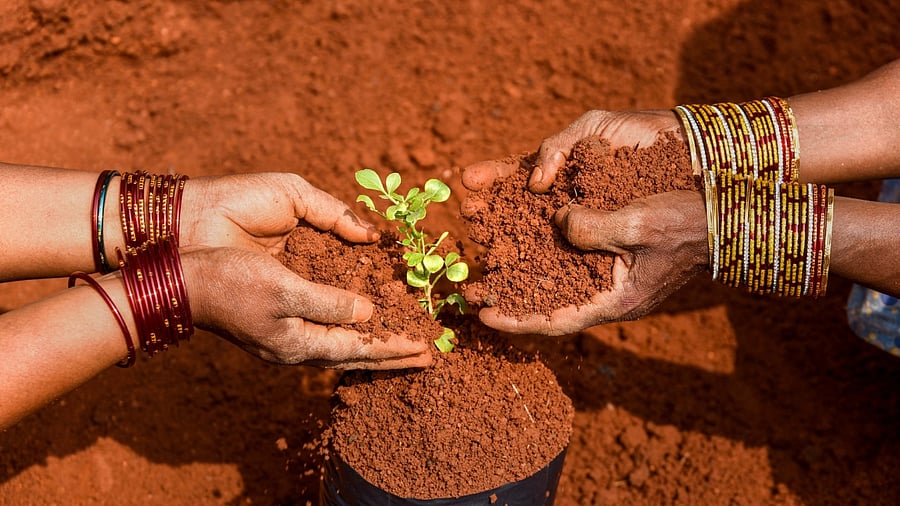
Carbon is a determinant of healthy soil. Organic carbon is food for soil organisms. The higher the percentage of carbon, the better and more diverse the soil microorganisms in it. Climate change is one of the biggest threats that nature faces in the decades ahead. The requirement for food production will be greater than ever, with the population rising to 8 billion in 2023. The biggest challenge for Indian agriculture is the poor organic carbon content in our soils.
Natural ecosystems have been severely exploited as a result of the Anthropocene era, which has also increased carbon dioxide levels. In the middle of the 18th century, carbon dioxide levels were 280 ppm; today, they are at 421 ppm. Both climate catastrophe and loss of nature are interrelated and must be tackled together. The natural world needs to recover so that it can cope with the climate change that is already happening.
Nature’s major systems such as agricultural lands, coastal ecosystems like wetlands and mangroves and grasslands and tropical rainforests are carbon sinks, playing an important role in climate change by absorbing more carbon than they release. These are the reservoirs through which carbon cycles.
Around 67 per cent of Indian states are low in soil organic carbon. Soil carbon is essential for water retention, controlling soil erosion, nutrient cycling and improving the soil structure. India, with 170 million hectares, has a huge potential for integrating soil organic carbon into its national mitigation strategies. Ecosystems with high biodiversity segregate and isolate more carbon in the soil.
Alternative sustainable management strategies help convert agricultural lands to improve crop productivity and carbon segregation. Practices like conservation tillage, natural alternatives in place of toxic chemicals, mixed crop rotations and encouraging biodiversity etc. will help in the restoration of degraded soils and ecosystems.
Wetlands are among the most productive ecosystems in the world. Wetland paddy has higher carbon-storing potential, given the strong aggregate stability of paddy soils and soil microbe species load. Large-scale conversion of wetland paddy is rampant because of the failing economics of paddy cultivation. It’s very critical to maintain paddy wetlands without causing them much destruction.
Mangrove ecosystems are one of the most productive and diverse ecosystems in the world. They only make up around 0.1 per cent of the planet’s surface, yet they are responsible for 10 per cent of the dissolved organic carbon discharged into the ocean and 11 per cent of the total terrestrial carbon absorbed into the ocean, making their preservation vital for reducing global carbon emissions.
Over the past century, India has lost 40 per cent of its mangrove cover. For instance, Kerala has lost 90 per cent of its mangroves during the past three decades.
Mangroves are breeding grounds for marine biodiversity and fish depend on healthy mangrove ecosystems. As shrimp farms are excessively increasing, wetland paddy and mangroves are being removed at an alarming rate.
Site-specific, community-based restoration programmes are the need of the hour. It is imperative that all stakeholders become aware of the looming danger and push the government to take necessary steps to regulate shrimp farms and enforce specific laws for the conservation of mangrove forests because mangroves are a distinct and unique ecosystem.
Grasslands store approximately one-third of the global terrestrial carbon stocks and act as soil carbon sinks. Climate change has affected soil organic carbon storage of grasslands by modifying the processes of plant carbon inputs. Grasslands need to be carefully managed by judicious use of fertilisers, controlled grazing; sowing legumes and grasses or other species adapted to the environment and improving soil fauna can provide high carbon-gain options for grasslands.
Forests have high carbon sequestration rates, reaching up to three times that of wetlands and agro-ecosystems. Afforestation activities, however, may not always enhance the soil organic carbon. Agroforestry helps in conserving soil and improving the carbon content. With conversion to a permanent land cover, there is a large potential for improving carbon in soil through agricultural intensification.
Government incentives and policies are enabling climate-friendly agriculture along with land degradation neutrality by encouraging farmers to promote carbon farming through various technologies.
The Government of India has launched several policy programmes to deal with climate change and soil health management. The National Mission of Sustainable Agriculture (NMSA) was initiated to encourage farmers for judicious management of existing resources. Many organic farming schemes were launched from 2015 since croplands are extremely important in this effort, and as they are amenable to implementation of improved practices.
These croplands have lost a large percentage of their carbon and can re-absorb it through the introduction and adoption of improved or proper management. This mission was under the National Action Plan on Climate Change (NAPCC). In 2015, India had also established the Soil Health Card to recommend the fertiliser dosage for crops based on soil test results.
It is necessary to establish government programmes that can offer a variety of advantages, including the provision of food, fish, and coastal livelihoods, carbon sequestration, flood control, erosion reduction, storm protection, sedimentation, pollution control, groundwater protection against salt intrusion, biodiversity preservation, wave reduction, tourism development and the provision of forest products.
More coordinated soil organic carbon sequestration plans and programmes that could both boost agricultural output and slow global warming need to be implemented, which could at the same time increase agricultural productivity and mitigate climate change.
Thus, it is crucial that industrialised nations and international organisations work together to execute comprehensive programmes to rehabilitate degraded soils around the world in order to sequester carbon and increase production.
(The author is a sustainability expert, independent researcher and agri journalist)